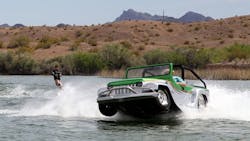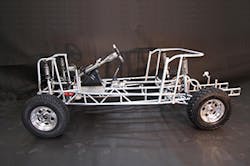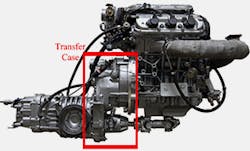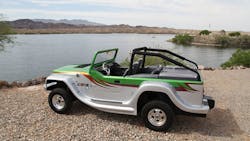The Panther, an amphibious car from WaterCar Inc., has a top speed of 44 mph, a world record for amphibious cars. On solid ground, the Panther goes up to 80 mph. Each Panther is hand-built by Fountain Valley Body Works (Fountain Valley, CA), with a Honda 3.7 liter V6 SOHC VTEC engine, a four-speed manual transmission, fiberglass hull, and hydraulically retractable wheels that let it go from operating on land to cruising across the water at the push of a button. A classic SUV was the inspiration for the Panther’s looks. The 2,950-lb Panther measures 69 in. tall, 180 in. long and 72 in. wide. It seats four and runs on 91 octane fuel.
The framework of the car consists of a hull and chromoly chassis epoxied together. The chassis, which resembles a sand rail dragster, resists impacts on land and water. The non-corrosive fiberglass body makes the Panther stronger than most boats and durable on the street. The hull is filled with 32 ft3of U.S. Coast Guard-approved closed cell styrofoam, which makes the Panther unsinkable.
Fountain Valley Body Works builds WaterCar’s design with narrow 20-lb racing wheels that are 30 inches in diameter. The wheels are moved 15 in. up and out of the water by a two inch hydraulic cylinder that looks like an off road shock. The Panther’s wheel wells are sealed off so that water cannot enter the vehicle. When on solid ground, the Panther has the suspension of an off road vehicle.
The durable transfer case efficiently transfers power from the motor to the jet or transmission. Quick Change Gears from Winters Performance Products Inc.(York, Penn.), in the transfer case, can handle over a 1,000 hp.
When operating like a boat, the Panther’s cooling system relies on an intercooler and a conventional radiator. The water-cooled engine mounts in a watertight bay on the bottom of the hull. The engine’s heat leaves through a vent on the engine cover in the front of the Panther.
Water that builds up in the bottom of the boat can be pumped out by a pair of bilge pumps. The pumps are under the engine and additional ones can be placed under the front hood.
On land, the engine is cooled by a set of mechanical and electric fans. The mechanical fans’ speed is controlled by the speed of the vehicle—the faster the Panther travels, the faster the fans spin. It takes eight HP to run the mechanical fans, and a third of a horse power to run the electric fans.
Water that builds up in the bottom of the boat can be pumped out by a pair of bilge pumps. The pumps are under the engine and additional ones can be placed under the front hood. The Panther, like a jet ski, can reverse in water. A nozzle on the water jet moves downward when the vehicle is placed in reverse. The Panther takes 15 seconds to transition between land and boat mode.
You can buy WaterCar’s Panther through their Web site for $135,000. Watch a demo of the Panther in the video below.
About the Author
Richard Dryden
Richard Dryden is a writer with experience in print and online media as well as social media. He has contributed to Machine Design and Hydraulics & Pneumatics.




